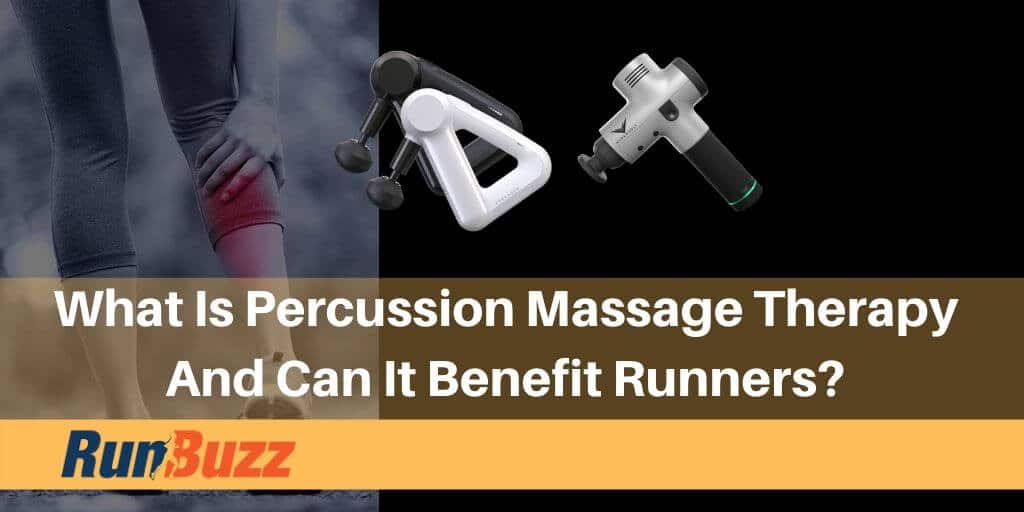Percussion massage therapy and the use of percussion massage guns have been all the rage on social media streams lately.
I don’t know about you, but when I first saw images of athletes getting their muscles pummeled by a device that looks like a fancy woodworking jigsaw, I was skeptical.
Not anymore.
So what is percussion massage and do percussion massage guns work?
These are the questions I set out to answer in this article.
The quick answer to “Do massage guns work?” is yes. They do work. But it also depends on what you plan to use a massage gun for.
A massage gun, like this Theragun 4th generation Pro model will definitely help you feel better and help you heal faster but you still have to match proper recovery with the adequate amount of rest and recovery. If you want to read about my experience using the Hyperice Hypervolt percussion massager, I wrote a detailed review here.
I also wrote a detailed review on a cheaper model here. It is a Cholas massage gun that is not as powerful, but you can’t beat the cost and performance for a massage gun under $35. It is no Theragun or Hypervolt, but it can be a decent starter massage gun.
When it comes to claims like do massage guns improve blood flow or reduce post exercise muscle soreness, the research is there to show that percussion massage therapy does work. In fact, percussion massage therapy has been around long before massage guns were even invented. Massage guns are just tools to make our life easier when it comes to applying self-massage techniques.
What Is Percussion Massage Therapy?
Percussion massage therapy is actually a type of massage that has been around for a long time. Percussion massagers, otherwise referred to as massage guns are a tool to help apply percussion massage to anyone who wants to simulate a deep tissue massage or vibration massage.
Percussion massage guns work by delivering a series of rapid strikes, or blows to your muscles and soft tissues in order to increase blood flow to the area and increase your muscle range of motion.
Proponents of percussion massage claim that massage guns help promote pain relief from post workout soreness to promoting faster, soft tissue repair and healing.
Percussion massage guns mimic soft tissue massage techniques that some massage therapists do in order to deliver a form of deep tissue massage. These devices apply rapid, highly targeted pulse vibrations to a target area like your back, quads, hamstrings, calfs, adductors, hands, feet, shoulders, neck and arms.
Various attachments are used to deliver slightly different strikes and vibrations to various trouble spots you may have.
What Are The Benefits Of Using A Massage Gun?
Here are some of the benefits of using percussion massagers:
- Helps increase blood flow to your muscles and remove lymphastic waste fluids that collect as part of intense exercise and inflammation.
- Helps reduce muscle inflammation and post exercise soreness, like DOMS (Delayed Onset Muscle Soreness)
- Helps reduce and eliminate muscle adhesions. These are the knots and trigger points that develop naturally over time as muscle heals.
- Helps increase overall mobility, flexibility and range of motion by keeping muscle fascia loose and frictionless
- Helps activate the nervous system to give us an amazing post-massage feeling of relaxation and stress reduction.
When Should You Not Use A Massage Gun?
There are actually situations when you should not use a massage gun. Primarily it comes down to preexisting conditions like pulled muscles or broken bones. However, just like any form of massage or self myofascial release techniques like foam rolling, you should not perform them without seeking medical advise first. A massage gun is no different.
Here is a list of conditions or situations where you should not use a massage gun without seeking medical advice first.
- Muscle strains and sprains
- Injuries that result in chronic inflammation
- Broken bones or suspected broken bones
- Sprains
- High Blood Pressure
- Varicose veins
- Osteoporosis (bone degeneration)
- Conditions that affect your blood vessels (atherosclerosis, deep vein thrombosis, peripheral artery disease, etc)
- Autoimmune conditions such as multiple sclerosis, lupus, etc.
- Rheumatoid arthritis, muscular dystrophy, osteoarthritis, fibromyalgia or gout.
Note: This is not an exhaustive list. If unsure if a massage gun is safe for you, please check with your doctor before using.
Do Massage Guns Work?
There is actually limited research available specific to the use of massage guns, however there is a decent amount of research available on percussion massage and vibration therapy itself.
As I researched the topic, most of the research was conducted using massage therapists to deliver the percussion techniques and not massage guns themselves. But that does not mean that they don’t work. In fact, I experienced it working on me in at least a few key areas. Other areas were harder for me to evaluate because I did not notice or could not tell.
Massage guns did not hit the mainstream until 2018, when the founder of Therabody (formerly known as Theragun) released their massage gun to the market.A few years prior, the founder, a physical therapist, was in a motorcycle accident and was struggling with pain that was not being solved through traditional treatment.
While home recovering, he created a rudimentary massage gun in his garage and found that the application of percussive techniques made his back feel better. As he researched why, he realized that percussion massage could help others and after working with some of his own patients and additional research, he decided to productize it with the invention of the Theragun. Once released, hundreds of other knock-offs started hitting the market.
One of the most popular research studies on percussion massage looked at three groups of women. One group received percussion massage therapy techniques, one group received traditional massage therapy techniques and the last group (the control group) received no massage at all.
Using a wide range of pre and post massage measurements, the results did back some of the claims that massage gun manufacturers are making. For example, both the traditional massage and the percussion massage research groups reported less post exercise (DOMS) soreness and the results were statistically equal among both groups. This indicates that both traditional massage and percussion massage is great at reducing muscle soreness.
Another key finding was that massage therapy was a bit better at helping the women recover strength faster over the percussion massage group and the control group (as measured by a one rep maximum strength test). I am not sure this is a useful finding, at least not in terms of helping runners. As runners what we want is faster healing.
Another key observation was that the percussion group saw a signifiant reduction in Lactate Dehydrogenase (LDH) after 48 hours. This is important because LDH is found in muscles after intense exercise and is a key blood marker indicating muscle damage and the need for healing.
The fact that the LDH was lower than the control group shows that the percussion massage group was healing faster. This is most likely due to the fact that both percussion massage and traditional sports massage increases blood flow and helps remove the metabolic waste that gets created during muscle use.
Sources and Citations
Imtiyaz S, Veqar Z, Shareef MY. To Compare the Effect of Vibration Therapy and Massage in Prevention of Delayed Onset Muscle Soreness (DOMS). J Clin Diagn Res. 2014;8(1):133‐136. doi:10.7860/JCDR/2014/7294.3971Pournot H, Tindel J, Testa R, Mathevon L, Lapole T. The Acute Effect of Local Vibration As a Recovery Modality from Exercise-Induced Increased Muscle Stiffness. J Sports Sci Med. 2016;15(1):142‐147. Published 2016 Feb 23.
- About the Author
- Latest Posts

Steve Carmichael is a running coach, sports performance coach, nutrition coach and has been a recreational runner for over 18 years. Steve holds multiple certifications as a certified running coach through the RRCA and USA Track and Field as well as he is a NASM certified personal trainer, and PN1-L1 certified nutrition coach.
Steve has been coaching since 2010 and has helped thousands of runners online and in the Central Ohio area maximize performance and run injury-free.
Steve is the founder of RunBuzz and Run For Performance.com. If you are interested in working with Steve though his online running and strength coaching services, feel free to reach out.

